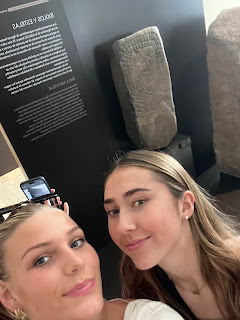5/17/24 Madrid Archeology Museum
For the Madrid Museum art choice, I decided to write about the idols and stelae that were carved into limestone slabs. These figurative art works were found in the Madrid Archaeological Museum and appeared on grey stone. These slabs can include different images such as humans or animals, and the one I observed depicted a human outline. This gave me an inside into the artistic depictions of humans during the Bronze Age. The image had view details, and like the informational description said, minimal details of the figurative art were normal for the time, and just enough detail was included to be identifiable.
Figurative art from the Bronze Age is important because like I mentioned before, it gives us an insight into the lives and beliefs of Prehistoric people. It's amazing that thousands of years later we can analyze their depictions and begin to connect the pieces as to what their life looked like. These stone drawings often depict the artistic capabilities and technological advances of their society by what they show. These figurative drawings play a massive role in helping researchers study this era. Students, teachers, and anyone in the public eye is able to learn about early human civilizations through the figurative drawings.
To conclude, the museum's collection, which showcases figurative art from prehistoric ages, shows narratives from that time. This museum contributes to a culture capital because researchers, students, and tourists. The unique and well preserved slabs of stone are great for initiating dialogue and eduction about the history of the depictions as well as daily life and customs during the Bronze Age. Historical artifacts significantly contribute to a city's significance because it allows the city to show off their history and possession of such artifacts. These slabs are rare because stone representations were quite rare in the Bronze Age, according to the informational paragraph next to the showcase.




Hey Laynee! I think your post does a great job describing how Madrid uses its art, history, and archeology to strengthen its position as a cultural capital. I love how you talk about the idols and stelae found in the museum and their significance of figurative art from the Bronze Age. I think it helps us understand the lives and beliefs of prehistoric people along with Madrid’s rich cultural heritage.
ReplyDeleteHi Laynee! There are some things that your blog post does really well in discussing the cultural capital of Madrid and how it is influenced by groups that lived in galicia and the ancient artifacts they have left behind. I assume that you are asserting that the presence of these artifacts in the madrid museum of archeology draws students, tourists, and researchers to the museum to study them and to learn about them. The scarcity of the artifacts further demonstrates Spain's ability to recognize and acknowledge the cultural contributions of groups in its borders despite their smaller size. I wish that there were even more inclusion of non-castilian groups in other museums. I feel like there's a lot of castilian centering going on elsewhere.
ReplyDeleteLaynee, I loved your comments about the limestone slabs in the archeology museum because the simple carvings stood out to me too! I loved that human culture is preserved through art all the way back to prehistoric times. It's amazing that we've taken care of these artifacts, studied them, drawn conclusions about early civilizations, and connected their relevance to our modern times! You did a great job encapsulating the cultural significance of these significant artifacts.
ReplyDeleteI love in this post how you describe how the Archaeological museum shows how Spain become a cultural capital. I love that you talk about all the different Ages and periods in Spain's time that have helped to shape the country. I love that you specific mention Figurative Art and how it was integral in the Bronze Age.
ReplyDeleteHey Laynee! Cool post and interesting choice of artifact, specially because it portrays how artifacts also can be forms of art. I think this contribute to Madrid as a cultural capital as its artifacts converge not simply artifacts and items used by humans. But also show the nuance of his ancient people also found art as a mode for expression expanding what we consider to be art.
ReplyDelete